A Hybrid Planning Approach Based on MPC and Parametric Curves for Overtaking Maneuvers
Abstract
1. Introduction
2. Review on Vehicle Motion under Unexpected Conditions
3. Hybrid Planning Approach
3.1. Bézier Nominal Trajectory
- The generated curve starts at control point and finishes in .
- The direction in the start and end of the trajectory are defined by and (Figure 3).
- The curve will lay into a convex hull formed by the control points.
- They are (geometrical) and (curvature) continuous.
- The amount of changes in curvature concavity is proportional to the changes of the vectors in .
3.2. MPC Maneuver Planning
3.2.1. Longitudinal Model
3.2.2. Lateral Model
3.2.3. Optimization Function
3.3. Combination of Both Trajectories
3.4. MPC Calculator: Constraints and Lateral/Longitudinal References
4. Experiment Set-Up
4.1. Tracking Controller Used
4.2. MPC Solver
4.3. Proving Ground and Testing Platform
5. Experimental Results
5.1. Low-Medium Speed Obstacle Avoidance
5.2. Medium-High Speed Obstacle Avoidance
5.3. Overtaking Scenario Using Virtual Environments
6. Discussion and Conclusions
Author Contributions
Funding
Acknowledgments
Conflicts of Interest
References
- Schrank, D.; Eisele, B.; Lomax, T. Urban Mobility Report 2019. Available online: https://static.tti.tamu.edu/tti.tamu.edu/documents/mobility-report-2019.pdf (accessed on 2 December 2020).
- Hegeman, G.; van der Horst, R.; Brookhuis, K.; Hoogendoorn, S. Functioning and Acceptance of Overtaking Assistant Design Tested in Driving Simulator Experiment. Transp. Res. Rec. J. Transp. Res. Board 2007, 2018, 45–52. [Google Scholar] [CrossRef]
- NHTSA. Traffic Safety Facts. Available online: https://crashstats.nhtsa.dot.gov/Api/Public/ViewPublication/811402 (accessed on 2 December 2020).
- NHTSA. Critical Reasons for Crashes Investigated in the National Motor Vehicle Crash Causation Survey. Available online: https://crashstats.nhtsa.dot.gov/Api/Public/ViewPublication/812506 (accessed on 2 December 2020).
- Mathers, C.D.; Loncar, D. Projections of Global Mortality and Burden of Disease from 2002 to 2030. PLoS Med. 2006, 3, e442. [Google Scholar] [CrossRef] [PubMed]
- Schoettle, B.; Sivak, M. Survey of Public Opinion about Autonomous and Self-Driving Vehicles in the U.S., the U.K., and Australia. Available online: https://deepblue.lib.umich.edu/handle/2027.42/108384 (accessed on 2 December 2020).
- Wang, F.; Yang, M.; Yang, R. Conflict-Probability-Estimation-Based Overtaking for Intelligent Vehicles. IEEE Trans. Intell. Transp. Syst. 2009, 10, 366–370. [Google Scholar] [CrossRef]
- Ulbrich, S.; Maurer, M. Probabilistic Online POMDP Decision Making for Lane Changes in Fully Automated Driving. In Proceedings of the IEEE International Conference on Intelligent Transportation Systems (ITSC), The Hague, The Netherlands, 6–9 October 2013; pp. 2063–2070. [Google Scholar]
- Desiraju, D.; Chantem, T.; Heaslip, K. Minimizing the Disruption of Traffic Flow of Automated Vehicles During Lane Changes. IEEE Trans. Intell. Transp. Syst. 2015, 16, 1249–1258. [Google Scholar] [CrossRef]
- NHTSA. Evaluation of Lane Change Collision Avoidance Systems Using the National Advanced Driving Simulator. Available online: https://trid.trb.org/view/1122849 (accessed on 2 December 2020).
- Zhang, C.; Zhu, J.; Wang, W.; Xi, J. Spatiotemporal Learning of Multivehicle Interaction Patterns in Lane-Change Scenarios. arXiv 2020, arXiv:2003.00759. [Google Scholar]
- Lim, W.; Lee, S.; Sunwoo, M.; Jo, K. Hierarchical Trajectory Planning of an Autonomous Car Based on the Integration of a Sampling and an Optimization Method. IEEE Trans. Intell. Transp. Syst. 2018, 19, 613–626. [Google Scholar] [CrossRef]
- Ariens, D.; Houska, B.; Ferreau, H.J. ACADO Toolkit User’s Manual. Optim. Eng. Cent. (OPTEC) 2014, 1, 1–116. [Google Scholar]
- Garrido, F.; González, L.; Milanés, V.; Rastelli, J.P.; Nashashibi, F. A Two-Stage Real-Time Path Planning: Application to the Overtaking Manuever. IEEE Access 2020, 8, 128730–128740. [Google Scholar] [CrossRef]
- Claussmann, L.; Revilloud, M.; Gruyer, D.; Glaser, S. A Review of Motion Planning for Highway Autonomous Driving. IEEE Trans. Intell. Transp. Syst. 2020, 21, 1826–1848. [Google Scholar] [CrossRef]
- Lattarulo, R.; Hess, D.; Pérez, J. A Linear Model Predictive Planning Approach for Overtaking Manoeuvres Under Possible Collision Circumstances. In Proceedings of the IEEE Intelligent Vehicles Symposium (IV), Changshu, China, 26–30 June 2018. [Google Scholar]
- González, D.; Pérez, J.; Lattarulo, R.; Milanés, V.; Nashashibi, F. Continuous curvature planning with obstacle avoidance capabilities in urban scenarios. In Proceedings of the IEEE 17th International IEEE Conference on Intelligent Transportation Systems (ITSC), Qingdao, China, 8–11 October 2014; pp. 1430–1435. [Google Scholar]
- Du, Z.; HomChaudhuri, B.; Pisu, P. Hierarchical Distributed Coordination Strategy of Connected and Automated Vehicles at Multiple Intersections. Taylor Fr. J. Intell. Transp. 2017, 22, 144–158. [Google Scholar] [CrossRef]
- Llorca, D.F.; Milanes, V.; Alonso, I.P.; Gavilan, M.; Daza, I.G.; Perez, J.; Sotelo, M.Á. Autonomous Pedestrian Collision Avoidance Using a Fuzzy Steering Controller. IEEE Trans. Intell. Transp. Syst. 2011, 12, 390–401. [Google Scholar] [CrossRef]
- Shamir, T. How Should an Autonomous Vehicle Overtake a Slower Moving Vehicle: Design and Analysis of an Optimal Trajectory. IEEE Trans. Autom. Control. 2004, 49, 607–610. [Google Scholar] [CrossRef]
- Cheng, G.; Wu, L.; Xu, L.; Qin, L.; Wang, Y. Overtaking Safety Evaluation and Setting of Auxiliary Lane on Two-Lane Highway in China. Math. Probl. Eng. 2016, 2016, 2603828. [Google Scholar] [CrossRef]
- Vlahogianni, E.I. Modeling duration of overtaking in two lane highways. Transp. Res. Part F Traffic Psychol. Behav. 2013, 20, 135–146. [Google Scholar] [CrossRef]
- Olaverri-Monreal, C.; Gomes, P.; Fernandes, R.; Vieira, F.; Ferreira, M. The See-Through System: A VANET-enabled assistant for overtaking maneuvers. In Proceedings of the IEEE Intelligent Vehicles syMposium (IV), San Diego, CA, USA, 21–24 June 2010; pp. 123–128. [Google Scholar] [CrossRef]
- Farah, H.; Bekhor, S.; Polus, A. Risk evaluation by modeling of passing behavior on two-lane rural highways. Accid. Anal. Prev. 2009, 41, 887–894. [Google Scholar] [CrossRef]
- Milanés, V.; Llorca, D.F.; Villagrá, J.; Pérez, J.; Fernández, C.; Parra, I.; González, C.; Sotelo, M.A. Intelligent automatic overtaking system using vision for vehicle detection. Expert Syst. Appl. 2012, 39, 3362–3373. [Google Scholar] [CrossRef]
- Lattarulo, R.; Marcano, M.; Pérez, J. Overtaking maneuver for automated driving using virtual environments. In Proceedings of the International Conference on Computer Aided Systems Theory (EuroCAST), Las Palmas de Gran Canaria, Spain, 19–24 February 2017; pp. 446–453. [Google Scholar]
- Artuñedo, A.; Villagra, J.; Godoy, J. Real-Time Motion Planning Approach for Automated Driving in Urban Environments. IEEE Access 2019, 7, 180039–180053. [Google Scholar] [CrossRef]
- Lu, B.; He, H.; Yu, H.; Wang, H.; Li, G.; Shi, M.; Cao, D. Hybrid Path Planning Combining Potential Field with Sigmoid Curve for Autonomous Driving. Sensors 2020, 20, 7197. [Google Scholar] [CrossRef]
- Lu, B.; Li, G.; Yu, H.; Wang, H.; Guo, J.; Cao, D.; He, H. Adaptive Potential Field-Based Path Planning for Complex Autonomous Driving Scenarios. IEEE Access 2020, 8, 225294–225305. [Google Scholar]
- Gutjahr, B.; Gröll, L.; Werling, M. Lateral Vehicle Trajectory Optimization Using Constrained Linear Time-Varying MPC. IEEE Trans. Intell. Transp. Syst. 2017, 18, 1586–1595. [Google Scholar] [CrossRef]
- Qin, S.J.; Badgwell, T.A. A survey of industrial model predictive control technology. Control Eng. Pract. 2003, 11, 733–764. [Google Scholar] [CrossRef]
- Huang, Z.; Chu, D.; Wu, C.; He, Y. Path Planning and Cooperative Control for Automated Vehicle Platoon Using Hybrid Automata. IEEE Trans. Intell. Transp. Syst. 2018, 20, 959–974. [Google Scholar] [CrossRef]
- Erlien, S.M.; Fujita, S.; Gerdes, J.C. Shared Steering Control Using Safe Envelopes for Obstacle Avoidance and Vehicle Stability. IEEE Trans. Intell. Transp. Syst. 2016, 17, 441–451. [Google Scholar] [CrossRef]
- Ntousakis, I.A.; Nikolos, I.K.; Papageorgiou, M. Optimal vehicle trajectory planning in the context of cooperative merging on highways. Transp. Res. Part C Emerg. Technol. 2016, 71, 464–488. [Google Scholar] [CrossRef]
- Liu, P.; Ozguner, U.; Zhang, Y. Distributed MPC for cooperative highway driving and energyeconomy validation via microscopic simulations. Transp. Res. Part C Emerg. Technol. 2017, 77, 80–95. [Google Scholar] [CrossRef]
- Han, Y.; Hegyi, A.; Yuan, Y.; Hoogendoorn, S.; Papageorgiou, M.; Roncoli, C. Resolving freeway jam waves by discrete first-order modelbased predictive control of variable speed limits. Transp. Research Part C Emerg. Technol. 2017, 77, 405–420. [Google Scholar] [CrossRef]
- Kamal, M.A.S.; Taguchi, S.; Yoshimura, T. Efficient Driving on Multilane Roads Under a Connected Vehicle Environment. IEEE Trans. Intell. Transp. Syst. 2016, 17, 2541–2551. [Google Scholar] [CrossRef]
- de Lima, D.A.; Victorino, A.C. A Hybrid Controller for Vision-Based Navigation of Autonomous Vehicles in Urban Environments. IEEE Trans. Intell. Transp. Syst. 2016, 17, 2310–2323. [Google Scholar] [CrossRef]
- Ding, W.; Zhang, L.; Chen, J.; Shen, S. Safe Trajectory Generation for Complex Urban Environments Using Spatio-temporal Semantic Corridor. IEEE Robot. Autom. Lett. 2019, 4, 2997–3004. [Google Scholar] [CrossRef]
- Lee, H.; Son, C.Y.; Kim, H.J. Collision-Free Path Planning for Cooperative Aerial Manipulators Under Velocity and Curvature Constraints. IEEE Access 2019, 7, 171153–171162. [Google Scholar] [CrossRef]
- Lattarulo, R.; González, L.; Martí, E.; Matute, J.; Marcano, M.; Pérez, J. Urban Motion Planning Framework Based on N-Bézier Curves Considering Comfort and Safety. J. Adv. Transp. 2018, 2018, 6060924. [Google Scholar] [CrossRef]
- Lattarulo, R.; Pérez, J.; Dendaluce, M. A complete framework for developing and testing automated driving controllers. IFAC World Congr. 2017, 50, 258–263. [Google Scholar] [CrossRef]
- Pérez, J.; Lattarulo, R.; Nashashibi, F. Dynamic trajectory generation using continuous-curvature algorithms for door to door assistance vehicles. In Proceedings of the IEEE Intelligent Vehicles Symposium (IV), Dearborn, MI, USA, 8–11 June 2014; pp. 510–515. [Google Scholar]
- Pepy, R.; Lambert, A.; Mounier, H. Path Planning using a Dynamic Vehicle Model. In Proceedings of the IEEE International Conference on Information & Communication Technologies, Damascus, Syria, 24–28 April 2006; pp. 781–786. [Google Scholar]
- Werling, M.; Ziegler, J.; Kammel, S.; Thrun, S. Optimal trajectory generation for dynamic street scenarios in a Frenét Frame. In Proceedings of the IEEE International Conference on Robotics and Automation, Anchorage, AK, USA, 3–7 May 2010; pp. 987–993. [Google Scholar]
- Villagra, J.; Milanés, V.; Pérez, J.; Godoy, J. Smooth path and speed planning for an automated public transport vehicle. Robot. Auton. Syst. 2012, 60, 252–256. [Google Scholar] [CrossRef]
- Labakhua, L.; Nunes, U.; Rodrigues, R.; Leite, F.S. Smooth trajectory planning for fully automated passengers vehicles: Spline and clothoid based methods and its simulation. In Informatics in Control Automation and Robotics; Springer: Berlin/Heidelberg, Germany, 2008; pp. 169–182. [Google Scholar]
- Heß, D.; Lattarulo, R.; Pérez, J.; Hesse, T.; Köster, F. Negotiation of Cooperative Maneuvers for Automated Vehicles: Experimental Results. In Proceedings of the 2019 IEEE Intelligent Transportation Systems Conference (ITSC), Auckland, New Zealand, 27–30 October 2019; pp. 1545–1551. [Google Scholar]
- Pérez, J.; Nashashibi, F.; Lefaudeux, B.; Resende, P.; Pollard, E. Autonomous docking based on infrared system for electric vehicle charging in urban areas. Sens. J. 2013, 13, 2645–2663. [Google Scholar] [CrossRef]
- Pérez, J.; Milanés, V.; Godoy, J.; Villagrá, J.; Onieva, E. Cooperative controllers for highways based on human experience. Expert Syst. Appl. 2013, 40, 1024–1033. [Google Scholar] [CrossRef]
- Houska, B.; Ferreau, H.J.; Diehl, M. ACADO Toolkit—An Open-Source Framework for Automatic Control and Dynamic Optimization. Wiley Optim. Control. Appl. Methods 2011, 32, 298–312. [Google Scholar] [CrossRef]
- Ariens, D.; Houska, B.; Ferreau, H.J. ACADO for Matlab User’s Manual. Optim. Eng. Cent. (OPTEC) 2010, 1, 1–73. [Google Scholar]
- Marcano, M.; Matute, J.A.; Lattarulo, R.; Martí, E.; Pérez, J. Low speed longitudinal control algorithms for automated vehicles in simulation and real platforms. Complexity 2018, 2018, 7615123. [Google Scholar] [CrossRef]
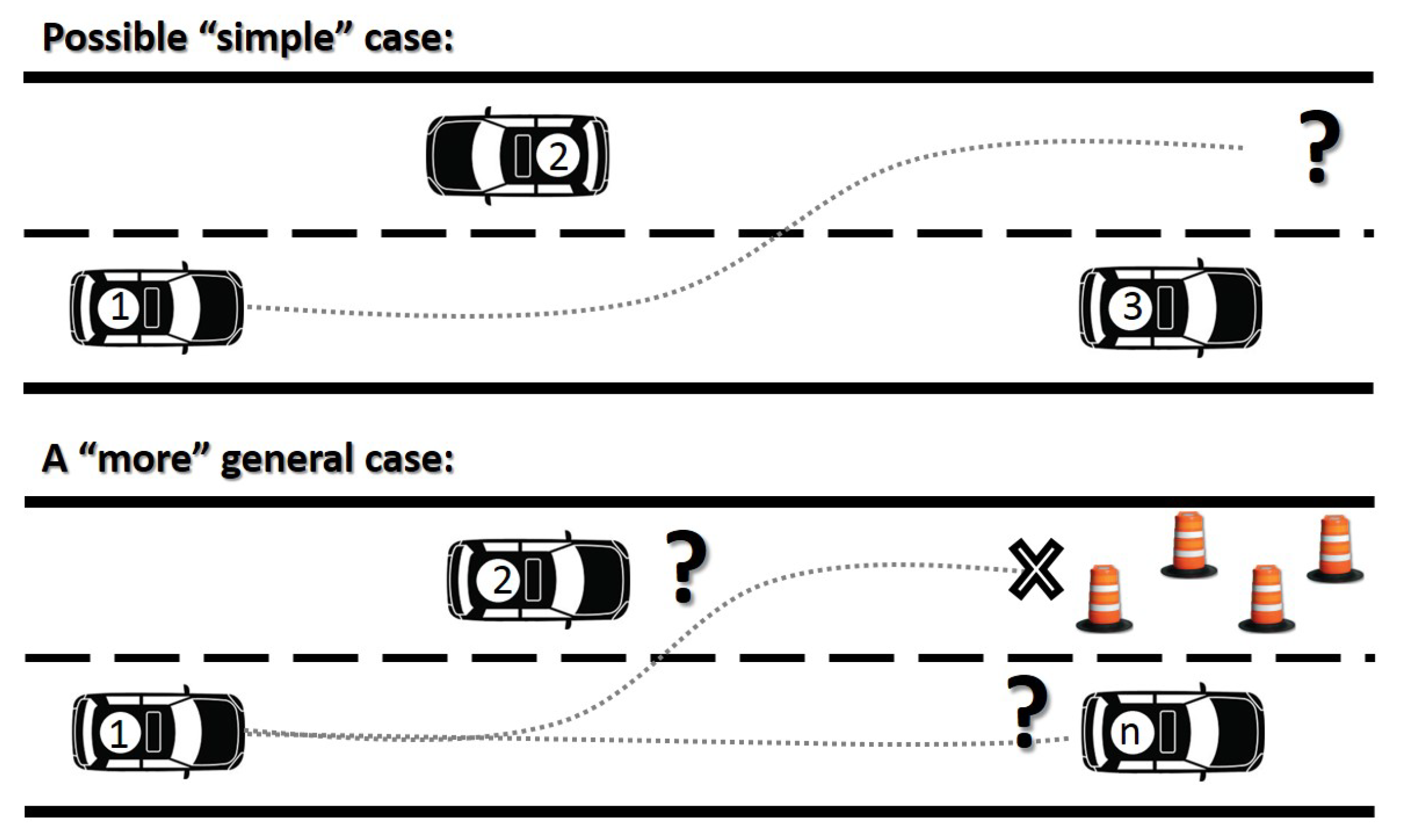
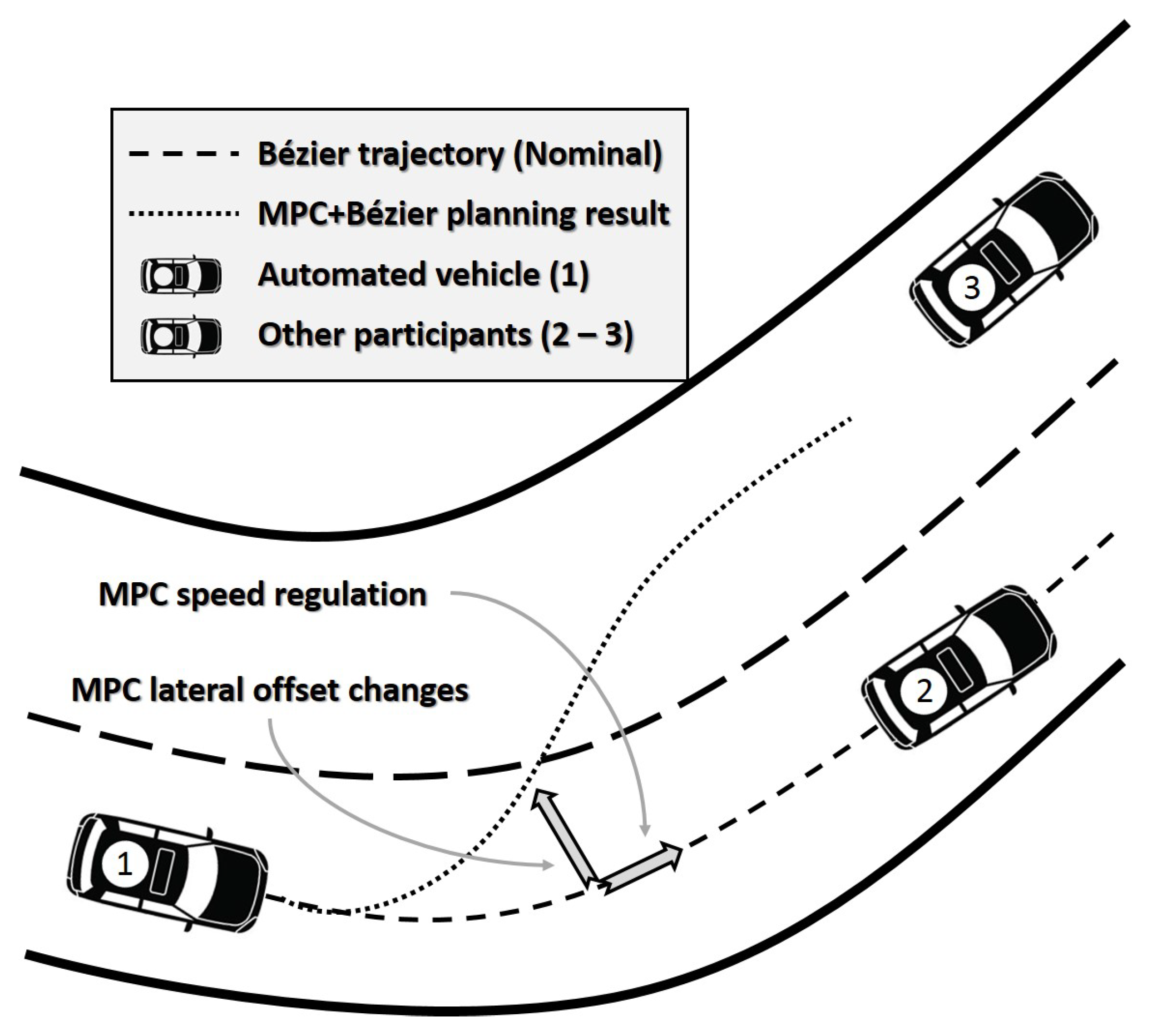
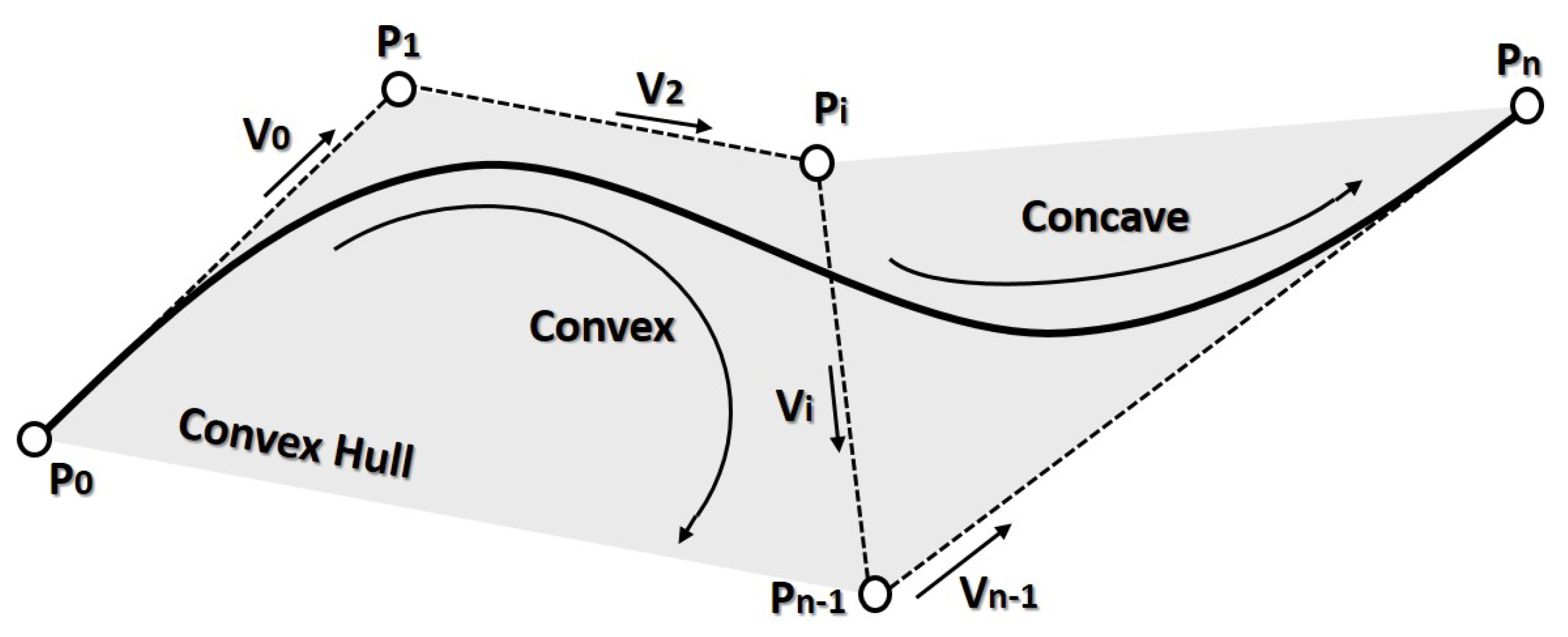
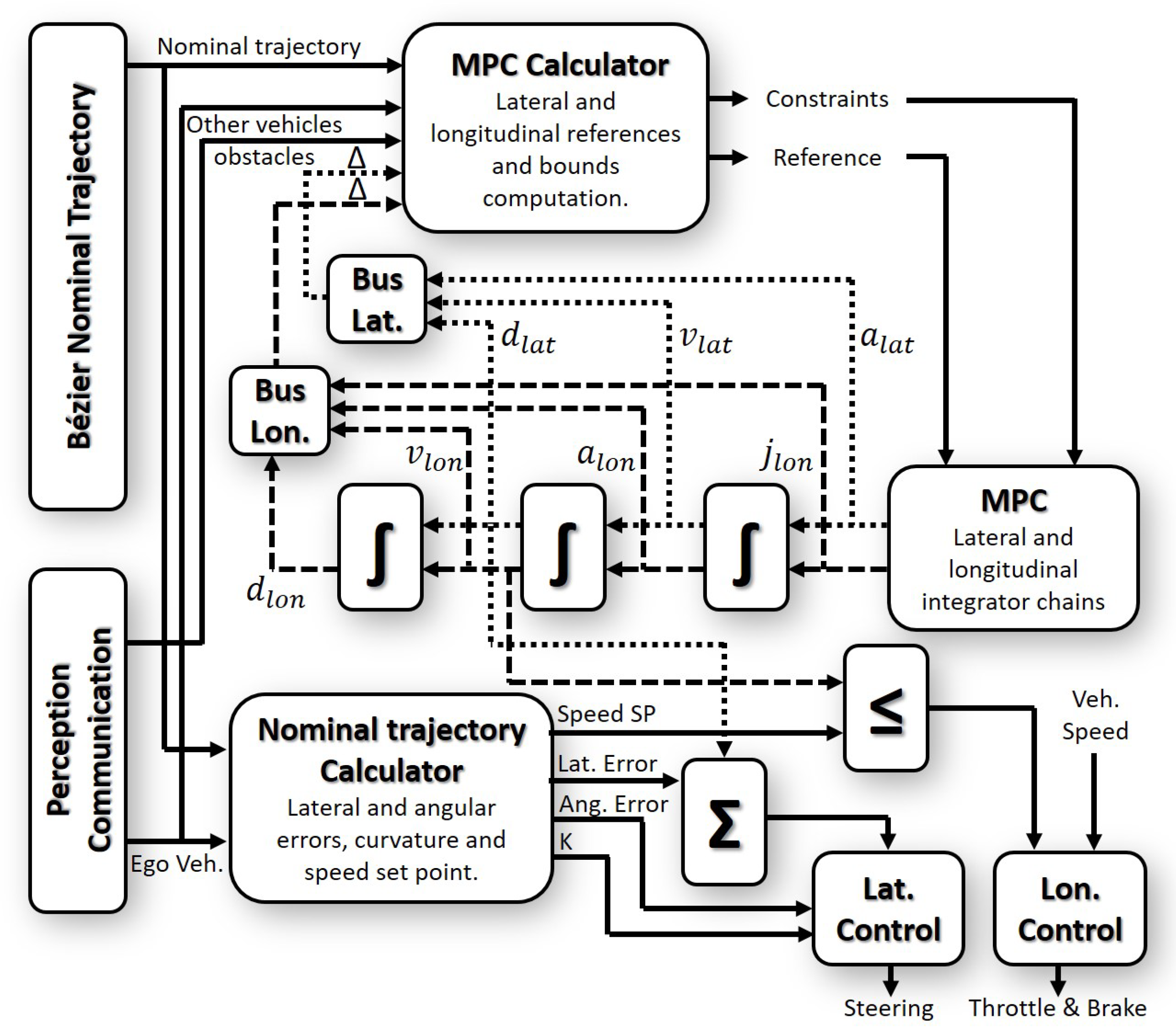
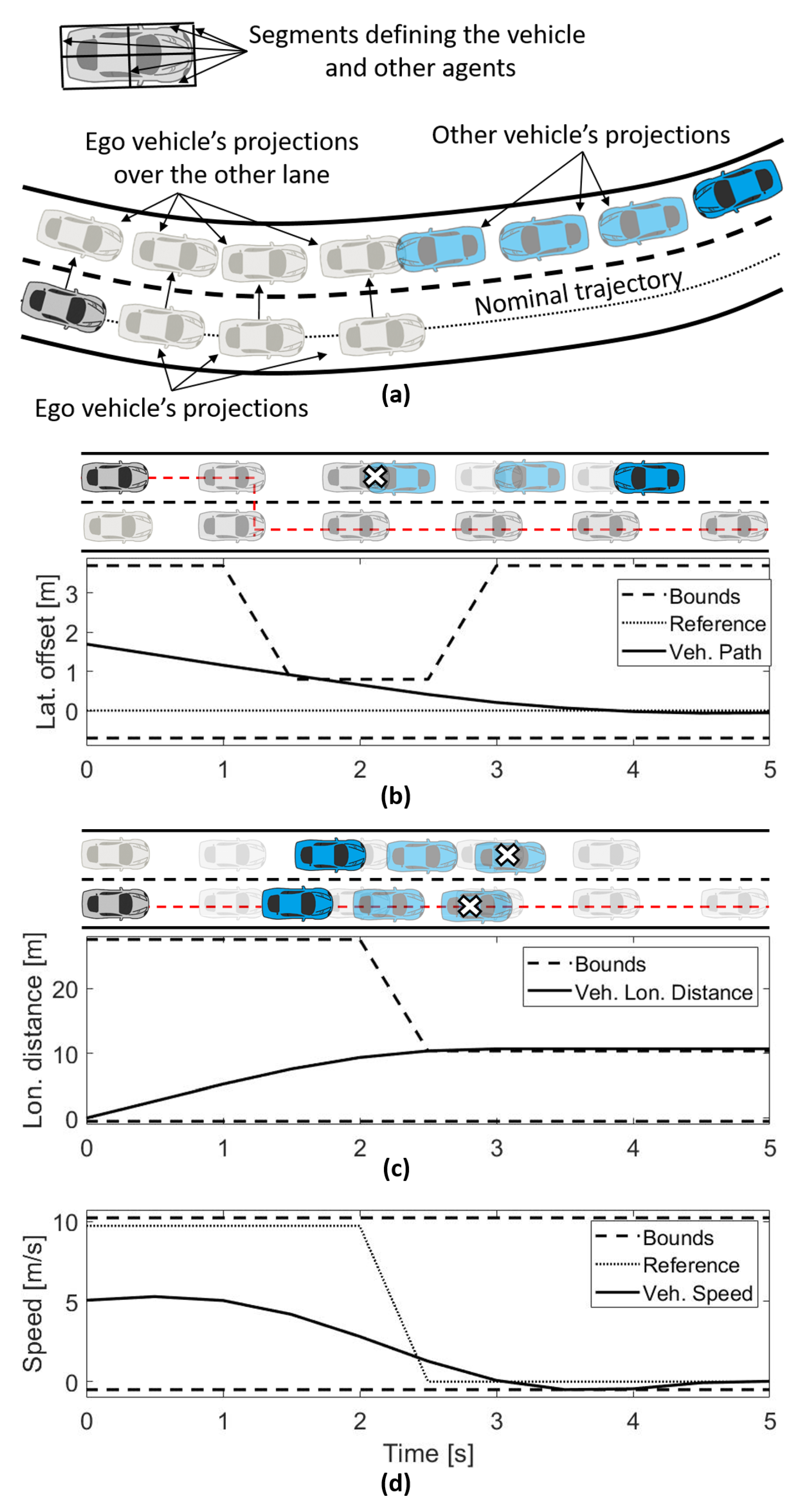





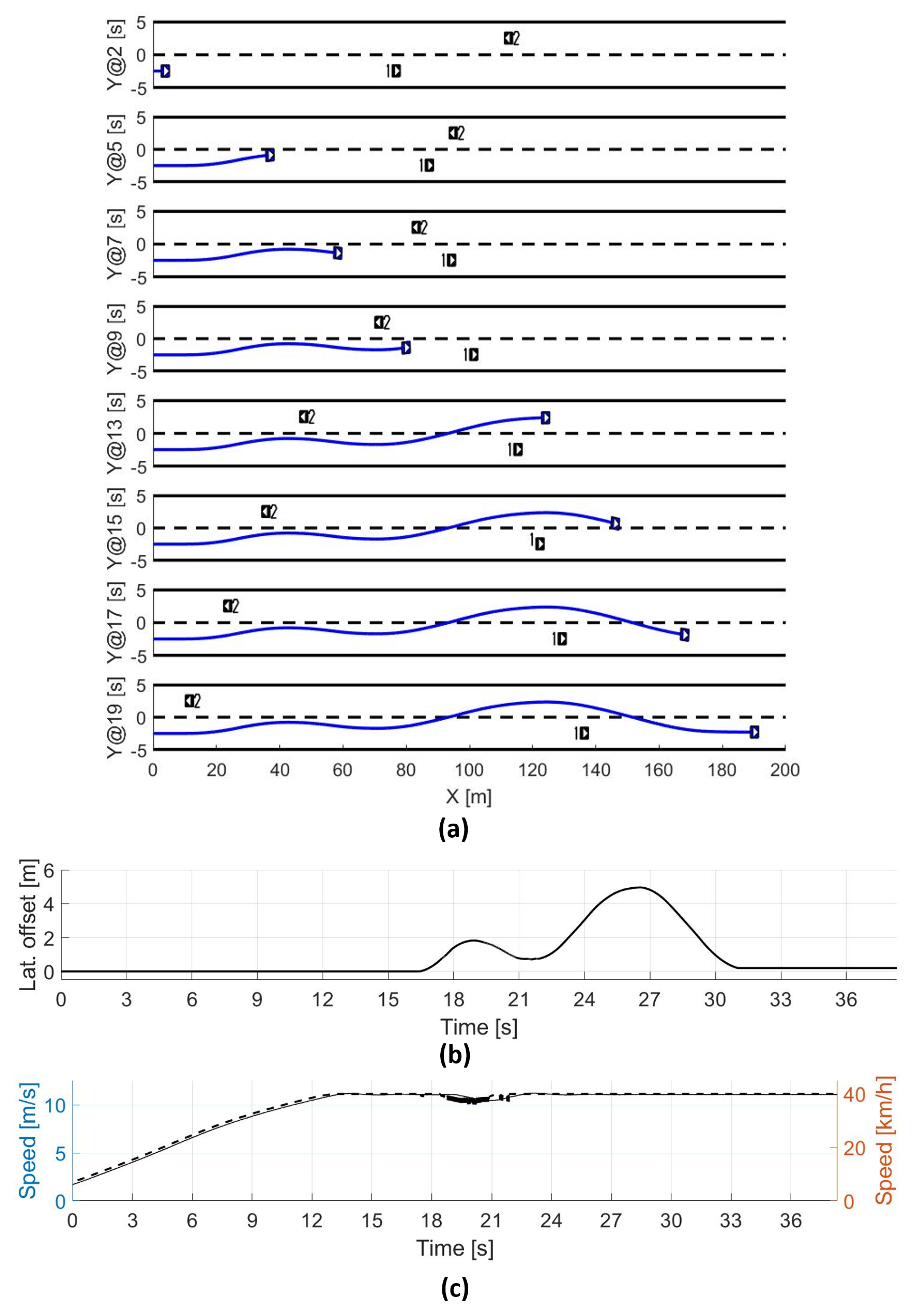
| Property | Value |
|---|---|
| Length | 2.40 (m) |
| Width | 1.30 (m) |
| Max. Speed | 22.22 (m/s) |
| Max. Acceleration | 1.00 (m/s) |
| Max. Deceleration | 3.15 (m/s) |
| Technique | Computation Time | Complexity Environment | Constraints | Result |
|---|---|---|---|---|
| Bézier | low-medium | low-medium | difficult | and continous |
| Linear MPC | medium | high | easy | fit vehicle dynamics with |
| a normal performance | ||||
| Non-Linear MPC | high | high | easy | fit very well |
| vehicle dynamics | ||||
| Proposed approach (hybrid) | medium | medium | easy-medium | average and fast performance |
Publisher’s Note: MDPI stays neutral with regard to jurisdictional claims in published maps and institutional affiliations. |
© 2021 by the authors. Licensee MDPI, Basel, Switzerland. This article is an open access article distributed under the terms and conditions of the Creative Commons Attribution (CC BY) license (http://creativecommons.org/licenses/by/4.0/).
Share and Cite
Lattarulo, R.; Pérez Rastelli, J. A Hybrid Planning Approach Based on MPC and Parametric Curves for Overtaking Maneuvers. Sensors 2021, 21, 595. https://doi.org/10.3390/s21020595
Lattarulo R, Pérez Rastelli J. A Hybrid Planning Approach Based on MPC and Parametric Curves for Overtaking Maneuvers. Sensors. 2021; 21(2):595. https://doi.org/10.3390/s21020595
Chicago/Turabian StyleLattarulo, Ray, and Joshué Pérez Rastelli. 2021. "A Hybrid Planning Approach Based on MPC and Parametric Curves for Overtaking Maneuvers" Sensors 21, no. 2: 595. https://doi.org/10.3390/s21020595
APA StyleLattarulo, R., & Pérez Rastelli, J. (2021). A Hybrid Planning Approach Based on MPC and Parametric Curves for Overtaking Maneuvers. Sensors, 21(2), 595. https://doi.org/10.3390/s21020595





